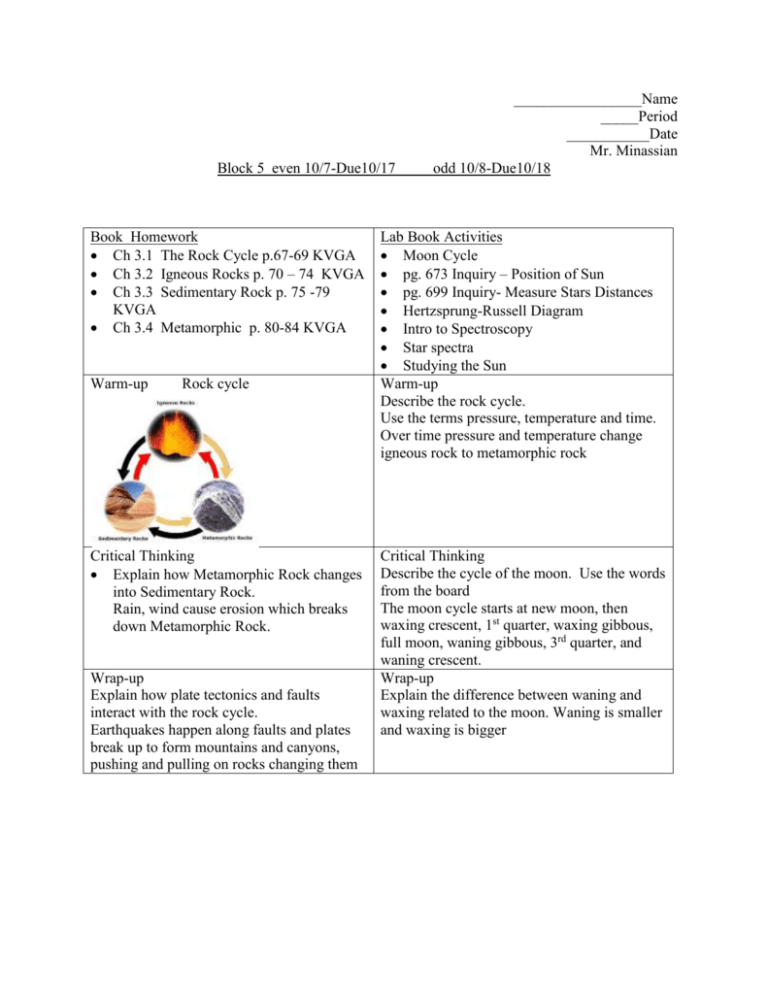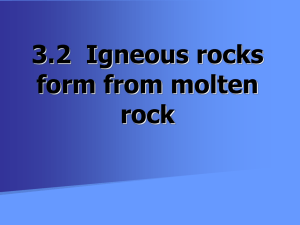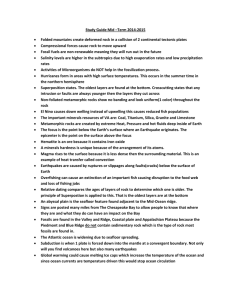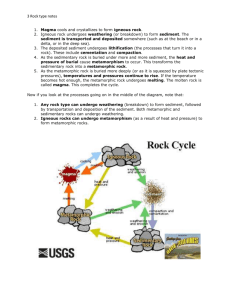_____Period ___________Date Mr. Minassian Book Homework Ch
advertisement

Block 5 even 10/7-Due10/17 Book Homework Ch 3.1 The Rock Cycle p.67-69 KVGA Ch 3.2 Igneous Rocks p. 70 – 74 KVGA Ch 3.3 Sedimentary Rock p. 75 -79 KVGA Ch 3.4 Metamorphic p. 80-84 KVGA Warm-up Rock cycle Critical Thinking Explain how Metamorphic Rock changes into Sedimentary Rock. Rain, wind cause erosion which breaks down Metamorphic Rock. Wrap-up Explain how plate tectonics and faults interact with the rock cycle. Earthquakes happen along faults and plates break up to form mountains and canyons, pushing and pulling on rocks changing them _________________Name _____Period ___________Date Mr. Minassian odd 10/8-Due10/18 Lab Book Activities Moon Cycle pg. 673 Inquiry – Position of Sun pg. 699 Inquiry- Measure Stars Distances Hertzsprung-Russell Diagram Intro to Spectroscopy Star spectra Studying the Sun Warm-up Describe the rock cycle. Use the terms pressure, temperature and time. Over time pressure and temperature change igneous rock to metamorphic rock Critical Thinking Describe the cycle of the moon. Use the words from the board The moon cycle starts at new moon, then waxing crescent, 1st quarter, waxing gibbous, full moon, waning gibbous, 3rd quarter, and waning crescent. Wrap-up Explain the difference between waning and waxing related to the moon. Waning is smaller and waxing is bigger Warm-up What is the relationship between the color of a star and the temperature of the star? Blue is the hottest, Orange is in the middle and red is least. Warm-up How does a metamorphic rock become a new rock even though it comes from igneous or sedimentary rocks? The original rock is subjected to great temperatures, pressure, erosion causing physical and/or chemical change. Critical Thinking On the graph what part is labeled main sequence? in the middle Top left, bottom right Wrap-up Why is red a cooler (temp.) color than blue? red has less energy Critical Thinking Distinguish between clastic sedimentary rocks and chemical sedimentary rocks. Clastic rocks are sedimentary rocks that are formed from eroded rock particles that vary in size from microscopic to boulder. Chemical sedimentary rocks are formed from evaporation of, or precipitation from, chemical rich waters. Wrap-up Identify the features that are unique to some sedimentary rocks. Sedimentary rocks could be, or exhibit: Sedimentary layers from cyclical deposition. The presence of fossil organisms. Be derived from organic processes (like coal). Be more porous and less dense than other rock types. Reaction to dilute acids. Formed of particles of other rock fragments. Fine grained. Created by evaporation of saturated solutions. Ch 3.1 The rock cycle pg. 66 Key concepts Rock is an abiotic object, earth, soil, crystals and minerals. Three types are igneous, metamorphic, and sedimentary. The rocks differ by shape, texture, material and color. The rock cycle is a model that demonstrates the order rock change. Gravity, pressure and temperature, drive the rock cycle. Vocabulary1. Rock- solid matter, natural 2. Igneous rock- from magma intrusive from lava extrusive 3. Sedimentary rock- crushed metamorphic / igneous rock then pressed together 4. metamorphic rock-changed due to press, temp 5. rock cycle- igneous to metamorphic to sediment and back 6. magma- molten rock inside earth 7. lava- molten rock outside earth 8. weathering- erosion due to wind and water 9. sediments-small particles of rock, sand Graphic organizer Rock Silicone, and other minerals Igneous Magma, lava Sedimentary Harden igneous, metamorphic Sediment Silicone mixed with oxygen Assessment1. A rock is the earth’s material that is dead 2. Igneous, metamorphic, sedimentary 3. Igneous rock is lava, metamorphic, changes igneous. 4. Rock cycle is model of rock moving through the earth 5. Pressure, temperature and the sun power the cycle 6. Igneous rock is softer than metamorphic rock. 7. Sedimentary rock melts under earth then erupts as lava to make igneous rock. 3.2 Igneous Rocks Key Concepts How are intrusive and extrusive igneous rocks alike and different? Rocks that form when magma hardens beneath Earth’s surface are called intrusive igneous rocks. When lava hardens, the rocks that form are called extrusive igneous rocks. How does the rate of cooling affect an igneous rock’s texture? Slow cooling results in the formation of large crystals Rapid cooling of magma or lava results in rocks with small, interconnected mineral grains. How are igneous rocks classified according to composition? Granitic composition- In addition to quartz and feldspar, most granitic rocks contain about 10% dark silicate minerals. These dark minerals are often biotite mica and amphibole. Granitic rocks contain about 70% silica and are the major rocks of the continental crust. Rhyolite is an extrusive granitic rock. Basaltic composition- rich in the elements magnesium and iron. Because of their iron content, basaltic rocks are typically darker and denser than granitic rocks. The most common basaltic rock is basalt, the ocean floor. Also, Gabbro an intrusive igneous rock Rocks with a composition between granitic and basaltic rocks have an andesitic composition. This group of igneous rocks is named after the common volcanic rock andesite. Andesitic rocks contain at least 25 percent dark silicate minerals— mainly amphibole, pyroxene, and biotite mica. 3.2 Vocabulary 3.2 Graphic Organizer ◆ Intrusive igneous rock A.1. rock that forms when magma ◆ Extrusive igneous rock hardens beneath Earth’s surface ◆ Porphyritic texture A.2. Common example of igneous intrusive rock is granite. ◆ Granitic composition B.1. rock that forms when lava hardens ◆ Basaltic composition B.2. Common example of igneous ◆ Andesitic composition extrusive rock is rhyolite. ◆ Ultramafic Section 3.2 Assessment Answers 1. Both types of rocks form when molten material cools and solidifies. Intrusive igneous rocks form when magma cools and solidifies within Earth. Extrusive igneous rocks form when lava cools and hardens at the surface. 2. Coarse-grained igneous rocks form when magma cools slowly within Earth. 3. Igneous rocks can be classified by composition based on the major minerals in the rocks. Light-colored rocks have granitic compositions. Dark-colored rocks have basaltic compositions. Dark-colored rocks that contain only olivine and pyroxene are ultra-mafic rocks. 4. Fine-grained igneous rocks form when lava cools quickly at Earth’s surface. 5. Igneous rocks with glassy textures form when lava cools very quickly. 6. Granite forms as magma slowly cools below the surface. This slow rate of cooling produces large mineral grains. Most of these minerals are quartz and feldspar, thus granite is light-colored, with a granitic composition. Basalt forms when lava cools quickly at the surface, resulting in very small mineral grains. The major minerals in basalt are dark-colored silicates that give basalt its dark color. 7. Lava is magma that reaches the surface. As it rises, reduced pressure on the magma causes some of its gases to come out of solution. These gases form bubbles or holes as the molten material cools 3.3 Sedimentary Rock Key Concepts Describe the major processes involved in the formation of sedimentary rocks. Erosion involves weathering and the removal of rock. When an agent of erosion—water, wind, ice, or gravity—loses energy, it drops the sediments. This process is called deposition. Compaction is a process that squeezes, or compacts, sediments. Cementation takes place when dissolved minerals are deposited in the tiny spaces among the sediments. What are clastic sedimentary rocks? Rocks that are made of weathered bits of rocks and minerals What are chemical sedimentary rocks? Forms when dissolved minerals precipitate from water solutions. What features are unique to some sedimentary rocks? Ripple marks, mud cracks, and fossils Vocabulary 3.3 ◆ Erosion ◆ Deposition ◆ Compaction ◆ Cementation ◆ Clastic sedimentary rock ◆ Chemical sedimentary rock Graphic organizer 3.3 A.1. rock made up of weathered bits of rocks and minerals A.2. Common example of clastic sedimentary rock is shale. B.1. rock that forms when dissolved minerals precipitate from water B.2. Common example of chemical sedimentary rock is limestone. Section 3.3 Assessment 1. Weathering is any process in which rocks are broken down into smaller pieces. Erosion involves the weathering and removal of sediments. Deposition is the dropping of sediments by agents of erosion. 2. Conglomerate, breccia, sandstone, shale, and siltstone are clastic rocks. Clastic rocks form when bits of weathered materials are compacted and cemented together. 3. Most limestone’s, rock salt, rock gypsum, flint, and chert are chemical sedimentary rocks that form when dissolved minerals precipitate from water. 4. Each layer of a sedimentary rock records a period of deposition. Ripple marks indicate that a rock bed formed in water. Mud cracks are indicative of unusually dry periods. Fossils can be used to determine if a rock formed on land or in the ocean, if the climate was hot or cold, or rainy or dry, and when the rock containing them formed. 5. Compaction is the process that squeezes, or compacts, sediments. 6. Cements are dissolved minerals that are deposited in the tiny places among the sediments. 7. Animals with shells died. The shells accumulated and became cemented to form a sedimentary rock. 8. Because they are smaller, clay particles undergo more compaction than sand-size particles. 9. Ripple marks indicate that a rock formed in water. And, because the ripple marks were pointing down, one can infer that the rock has been overturned from its original position Ch 3.4 Metamorphic Rocks Key Concepts Where does most metamorphism take place? Most metamorphic changes occur at elevated temperatures and pressures. These conditions are found a few kilometers below Earth’s surface and extend into the upper mantle How is contact metamorphism different from regional metamorphism? During contact metamorphism, hot magma moves into rock. Regional metamorphism results in large-scale deformation and high-grade metamorphism. What are three agents of metamorphism, and what kinds of changes do each cause? The agents of metamorphism are heat, pressure, and hydrothermal solutions. Heat provides the energy needed to drive chemical reactions. Some of these reactions cause existing minerals to recrystallize. Pressure on rocks causes the spaces between mineral grains to close. The result is a more compact rock with a greater density. This pressure also may cause minerals to recrystallize into new minerals. Solutions that surround mineral grains aid in recrystallization by making it easier for ions to move. When solutions increase in temperature reactions among substances can occur at a faster rate What are foliated metamorphic rocks, and how do they form? Some minerals recrystallize with a preferred orientation, which is at right angles to the direction of the force. The resulting alignment usually gives the rock a layered or banded appearance. This rock is called a foliated metamorphic rock. Gneiss, the metamorphic rock shown in Figure 18, is a foliated rock. Another foliated metamorphic rock is schist. How are metamorphic rocks classified? Most nonfoliated rocks contain only one mineral. Marble, for example, is a nonfoliated rock made of calcite. When its parent rock, limestone, is metamorphosed, the calcite crystals combine to form the larger interlocking crystals seen in marble. Vocabulary 3.4 ◆ metamorphism ◆ contact metamorphism ◆ regional metamorphism ◆ hydrothermal solution ◆ foliated metamorphic rock ◆ nonfoliated metamorphic rock Graphic Organizer 3.4 A.1. rock that forms when minerals recrystallize at right angles to the direction of pressure A.2. Common example of foliated metamorphic rock is slate. B.1. rock that does not have a banded texture B.2. Common example of nonfoliated metamorphic rock is marble. Section Assessment 3.4 1. Most metamorphism takes place in a zone that begins several kilometers below the surface and extends into the upper mantle. 2. Contact metamorphism is a process whereby slight changes occur in rocks as the result of an increase in temperature resulting from a magma body. Regional metamorphism, which is associated with mountain building, can result in high-grade changes in both composition and structure. 3. Heat can cause existing minerals to recrystallize or it can cause new minerals to form. Pressure produces a more compact rock with a greater density. Pressure also causes minerals to recrystallize. Fluids aid in recrystallization by making it easier for ions to move and by dissolving original minerals and depositing new ones. 4. Foliated rocks are banded metamorphic rocks that form when minerals realign as the result of pressure from opposing sides. 5. Metamorphic rocks can be classified according to composition and texture. 6. While both types of rocks form as the result of changes in temperature and pressure, metamorphism does not involve melting. 7. Schists, as indicated in Table 3, are the result of high-grade metamorphism that is generally associated with mountain-building. 8. Gneiss is a banded rock that forms as the result of pressure from opposing sides. This directional pressure results in foliation. However, because the parent rocks of gneisses can vary, so can the compositions of these metamorphic rocks.









